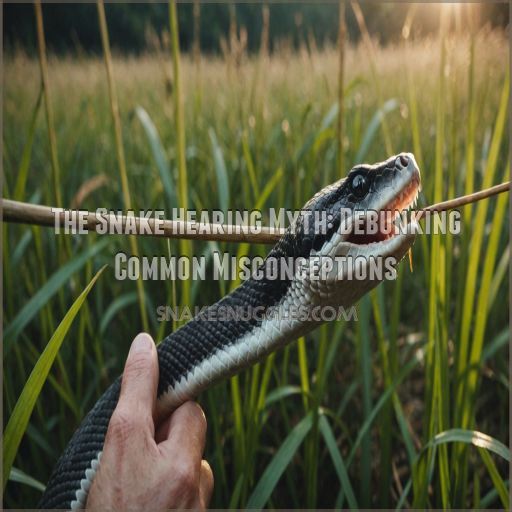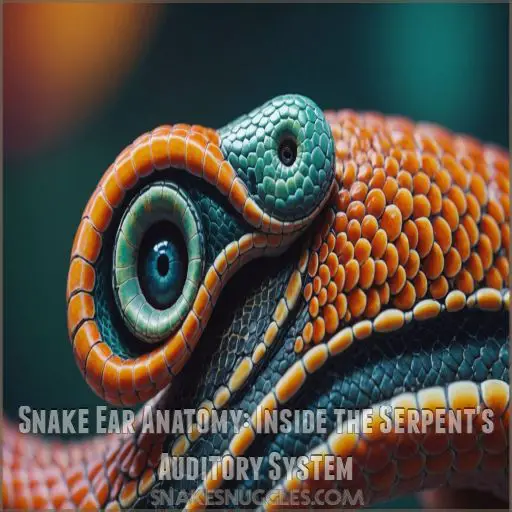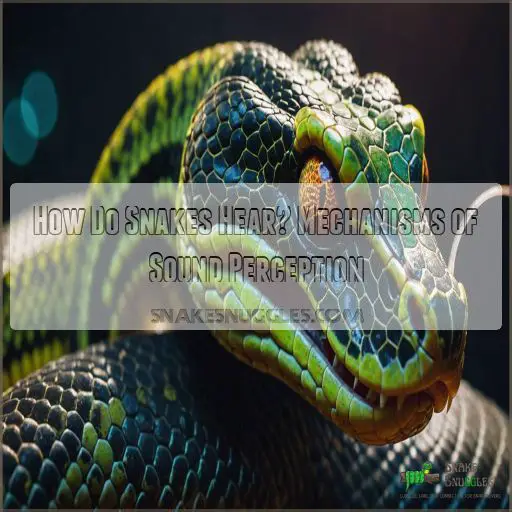This site is supported by our readers. We may earn a commission, at no cost to you, if you purchase through links.
 Yes, snakes can hear, but not in the way you might think!
Yes, snakes can hear, but not in the way you might think!
While they lack external ears, these slithery creatures have a unique auditory system tucked away inside their heads.
They’re like nature’s subwoofers, detecting low-frequency sounds and vibrations through their jawbones and inner ear structures.
So, while they won’t be jamming to your favorite tunes anytime soon, snakes are surprisingly in tune with their environment.
This hidden talent helps them hunt, avoid predators, and navigate their surroundings.
Who knew these "deaf" reptiles were actually secret sound specialists?
Turns out, there’s more to snake sensory perception than meets the eye—or should we say, ear?
Table Of Contents
- Key Takeaways
- The Snake Hearing Myth: Debunking Common Misconceptions
- Snake Ear Anatomy: Inside the Serpent’s Auditory System
- How Do Snakes Hear? Mechanisms of Sound Perception
- Frequently Asked Questions (FAQs)
- Can snakes hear humans?
- What sounds can be heard using a stethoscope?
- How do snakes hear?
- Can snakes hear people screaming?
- Can snakes hear low sounds?
- Can a pet snake hear you talking?
- Can snakes hear you talk to them?
- Do snakes react to sound?
- Is snake blind or deaf?
- Does noise scare snakes?
- Can snakes hear human voices?
- How well do snakes hear compared to humans?
- Do different snake species have varying hearing abilities?
- Can snakes distinguish between different types of sounds?
- How do snakes react to loud noises?
- Conclusion
Key Takeaways
- You might be surprised to learn that snakes aren’t deaf at all—they’re actually nature’s secret sound specialists! While they lack external ears, they’ve got a unique internal auditory system that lets them tune into their environment like living subwoofers.
- Don’t let their ear-less appearance fool you—snakes can hear both airborne sounds and ground vibrations. Their jawbones act like built-in microphones, picking up low-frequency sounds (think cello, not violin) and transmitting them to their inner ear structures.
- Next time you’re chatting near a snake, remember they might be eavesdropping! They can detect human voices, though it’s more like they’re hearing you through earmuffs. Their hearing range is limited to about 600 Hz, while you can hear up to 20,000 Hz.
- Understanding snake hearing isn’t just trivia—it’s crucial for conservation, safety, and better care of these misunderstood creatures. So the next time someone says snakes are deaf, you can confidently say, "That’s just a myth that’s been slithering around!
The Snake Hearing Myth: Debunking Common Misconceptions
You’ve probably heard that snakes are deaf, but this long-standing myth couldn’t be further from the truth.
While snakes lack external ears, they possess a sophisticated inner ear system connected to their jawbone, allowing them to detect vibrations and even some airborne sounds .
Historical Beliefs About Snake Deafness
Slithering through history, snakes have been shrouded in mystery and misconceptions. You might be surprised to learn that ancient beliefs about snake deafness persisted for centuries.
Let’s debunk some age-old myths:
- Ancient Greek mythology portrayed snakes as deaf creatures
- Australian folklore claimed snakes couldn’t hear threats
- Cultural influences reinforced the idea of snake deafness
- Literature often depicted snakes as silent, unresponsive beings
But hold onto your snake-skin boots, folks—science has some surprising revelations about serpent sound perception!
Lack of External Ears and Misconceptions
You’ve probably noticed that snakes don’t have visible ears like us.
This lack of external ears led many to believe that snakes were deaf .
It’s an easy mistake to make – after all, how can they hear without ears?
But nature’s full of surprises, and snakes are no exception.
Their unique anatomy has evolved clever ways to perceive sound, even without the ear flaps we’re used to seeing.
Scientific Evidence of Snake Hearing Abilities
While snakes may lack visible ears, recent research has shattered the myth of their deafness.
Scientists have uncovered fascinating evidence of snakes’ auditory abilities.
In a groundbreaking study, researchers tested 19 snakes from five species, exposing them to various sounds in a soundproof room.
Surprisingly, the snakes reacted to both airborne sounds and ground vibrations, proving they can indeed hear through the air.
Importance of Understanding Snake Sensory Perception
Now that we’ve cleared up the myth about snake deafness, let’s talk about why understanding snake sensory perception matters.
It’s not just about winning trivia night at your local herpetology club!
Grasping how snakes perceive their world helps us:
- Improve snake safety protocols
- Develop better conservation strategies
- Enhance captive care practices
- Deepen our appreciation for these misunderstood creatures
By unraveling the mysteries of snake senses, we’re not just splitting hairs – we’re scaling new heights in reptile research!
Snake Ear Anatomy: Inside the Serpent’s Auditory System
You might be surprised to learn that snakes do have ears, but they’re not what you’d expect.
Let’s take a peek inside a snake’s unique auditory system and uncover how these fascinating reptiles perceive sound without external ear openings learn about their sound perception.
Location and Structure of Snake Ears
Ever wondered where a snake’s ears are hiding? It’s not a trick question! Snakes do have ears, but they’re not where you’d expect. These slithery creatures have internal ears tucked away behind their eyes.
Let’s take a closer look at the unique auditory system of our serpentine friends:
| Feature | Location | Function |
|---|---|---|
| Ear Openings | Sides of head | Sound entry |
| Inner Ear | Behind eyes | Sound processing |
| Quadrate Bone | Jaw | Vibration transmission |
| Stapes | Inner ear | Sound amplification |
| Brain Connection | Skull base | Auditory interpretation |
Inner Ear Components in Snakes
Despite their lack of external ears, snakes possess intricate inner ear structures that allow them to perceive sound.
You’ll find a fully formed cochlea nestled within their skull, ready to translate vibrations into neural signals.
The stapes, a tiny bone connected to the jawbone, plays a key role in this auditory pathway.
It’s like having a built-in subwoofer, allowing snakes to pick up low-frequency vibrations with surprising accuracy.
Absence of Middle and Outer Ears
You might be surprised to learn that snakes lack the middle and outer ears we’re familiar with in most animals.
Unlike the complex ear structure you have, snakes have evolved a streamlined auditory system .
They’ve ditched the external ear flaps and ear canals, opting for a more minimalist approach to hearing.
It’s like they’ve gone for the "less is more" philosophy in their evolutionary journey!
Role of the Quadrate Bone in Snake Hearing
Have you ever wondered how snakes hear without external ears?
The secret lies in their quadrate bone.
This remarkable structure, part of the snake’s jaw, acts like a built-in microphone.
When sound waves hit the ground or air, the quadrate bone vibrates, transmitting these vibrations to the inner ear.
It’s nature’s clever workaround, allowing snakes to tune into their surroundings without traditional ears.
How Do Snakes Hear? Mechanisms of Sound Perception
You might think snakes can’t hear, but recent research reveals they’re not as deaf as we once believed.
Snakes use a unique combination of bone conduction and inner ear structures to detect both airborne sounds and ground vibrations, allowing them to interpret their environment in ways we’re only beginning to understand .
Vibration Detection Through Jawbones
In light of their lack of external ears, snakes have evolved a remarkable way to detect sound.
Their jawbones act as highly sensitive vibration receptors .
When a snake rests its head on the ground, vibrations from prey movements or potential threats travel through the substrate and into the snake’s jaw (Source).
This clever adaptation allows snakes to "hear" through the earth, giving them a unique advantage in hunting and survival.
Transmission of Sound to the Inner Ear
Once the snake’s jawbone picks up vibrations, it’s showtime for the inner ear!
The sound waves travel through specialized bones, making their way to the cochlea – the snake’s auditory command center (Source).
It’s like a game of telephone, but instead of whispers, it’s all about those vibrations.
The cochlea then turns these vibrations into signals the snake’s brain can understand.
Pretty slick, right?
Processing of Auditory Signals In
After sound vibrations reach a snake’s inner ear, you might wonder how they’re processed.
The brain steps in, transforming these vibrations into meaningful information .
Surprisingly, snakes are most sensitive to low-frequency sounds, around 80 to 160 hertz – think of the lowest notes on a cello.
This isn’t just snake trivia; it’s an incredible adaptation that helps these slithery creatures survive in their unique environments.
Frequently Asked Questions (FAQs)
Can snakes hear humans?
Imagine a snake as nature’s living microphone. They’re tuned into low frequencies, picking up sounds from 100-600Hz.
You’ll be surprised—they’re eavesdropping on your conversations! They can hear your voice!
What sounds can be heard using a stethoscope?
You’ll hear a symphony of bodily sounds with a stethoscope. From the rhythmic "lub-dub" of your heart to the whoosh of your breath, it picks up normal and abnormal noises in your chest.
helping doctors diagnose various conditions, including the rhythmic "lub-dub" of your heart.
How do snakes hear?
Like whispers in the wind, snakes’ hearing is subtle yet important.
You’re not imagining things – they can detect airborne sounds, particularly low frequencies below 600Hz.
Their inner ears pick up vibrations, helping them navigate their world (Source).
Can snakes hear people screaming?
Yes, snakes can hear people screaming.
They’re sensitive to low frequencies and are also sensitive to human voices. While they don’t hear as well as we do, loud voices or screams at close range are definitely within their hearing range .
Can snakes hear low sounds?
Snakes can definitely hear low-frequency sounds, typically below 600Hz .
They’re especially tuned into vibrations and low rumbles that might signal danger.
While they won’t catch your whispers, they’ll likely pick up on louder voices or screams.
Can a pet snake hear you talking?
Imagine your pet snake as a silent sentinel, attuned to the world’s vibrations.
You’ll be intrigued to learn that your scaly friend can indeed hear you talking, albeit in a muffled way, detecting frequencies below 600Hz.
Can snakes hear you talk to them?
You’ll be surprised to learn that snakes can indeed hear you talk! While they don’t have external ears, recent research shows they react to airborne sounds, including human voices, through their internal ear structures .
Do snakes react to sound?
Yes, snakes do react to sound, both airborne and ground vibrations. Different species respond uniquely – some move in the direction of sounds out of curiosity, while others retreat defensively. Their reactions vary based on frequency and volume .
Is snake blind or deaf?
You’d be surprised! Snakes aren’t blind or deaf. They’ve got decent vision and can hear low-frequency sounds. While their eyesight isn’t the best, they’ve evolved clever ways to compensate, like sensing vibrations through their bodies.
Does noise scare snakes?
Noise itself doesn’t scare snakes, but the vibrations it creates can startle them.
Stomping or making fast movements is more effective at frightening snakes away.
They’re sensitive to ground vibrations through their lower jaw.
Can snakes hear human voices?
Picture a snake, its forked tongue flicking – it’s not just tasting the air.
Its hidden ears are receptive to the world around them. Snakes can indeed hear human voices, albeit in a muffled, low-frequency range .
How well do snakes hear compared to humans?
Snakes’ hearing isn’t as sharp as yours. They can only detect low frequencies up to about 600 Hz. It’s like they’re listening through earmuffs all the time!
They can, while you can hear up to 20,000 Hz .
Do different snake species have varying hearing abilities?
Slithering serpents surprise scientists!
You’ll find fascinating differences in hearing abilities across snake species.
Woma pythons curiously approach sounds, while death adders, taipans, and brown snakes tend to retreat, showcasing diverse auditory adaptations .
Each species’ unique hearing helps it navigate its environment effectively.
Can snakes distinguish between different types of sounds?
You’ll be intrigued to know that snakes can indeed differentiate between sounds.
They’re particularly attuned to low-frequency vibrations, helping them detect prey or predators.
However, their ability to distinguish complex sounds isn’t as refined as humans’.
How do snakes react to loud noises?
When faced with loud noises, snakes typically display a startle response, similar to humans.
They may react with a fight-or-flight response, increasing heart rate and sweating.
Repeated loud sounds can stress snakes, potentially leading to health issues.
Conclusion
Despite their lack of external ears, snakes aren’t as deaf as a doorknob.
These slithery sound specialists can hear, just differently than we do.
Their unique auditory system allows them to detect low-frequency sounds and vibrations through their jawbones and inner ear structures .
So, next time you encounter a snake, remember that it’s tuned into its environment in ways we’re still uncovering.
Can snakes hear? Absolutely! They’re just marching to the beat of their own drum – or should we say, slithering to the vibrations of their own ground?









